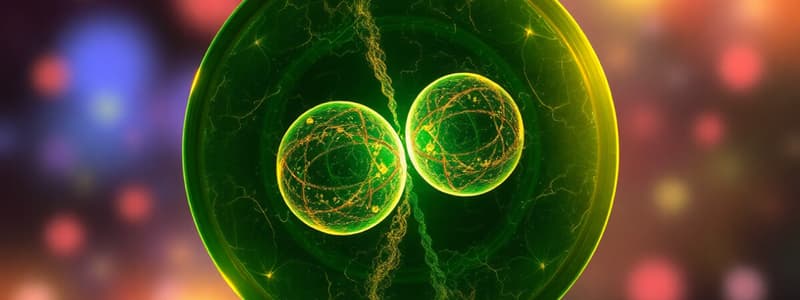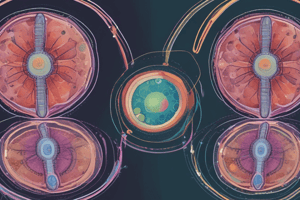Podcast
Questions and Answers
What occurs during telophase II in cell division?
What occurs during telophase II in cell division?
- Chromosomes decondense and a nuclear envelope reforms (correct)
- DNA replicates and cytokinesis begins
- Chromosomes condense and spindle fibers dissolve
- Gametes undergo fertilization and form zygotes
Which of the following is NOT a significance of cell division?
Which of the following is NOT a significance of cell division?
- Repairing damaged tissues
- Increasing metabolic rate in existing cells (correct)
- Growth and development of organisms
- Asexual reproduction
What mechanism do cyclins and cyclin-dependent kinases (CDKs) utilize in regulating the cell cycle?
What mechanism do cyclins and cyclin-dependent kinases (CDKs) utilize in regulating the cell cycle?
- They inhibit cell division at all times
- They activate the cell cycle progression through fluctuations (correct)
- They degrade damaged DNA to prevent cell division
- They fluctuate levels to activate checkpoints
How does meiosis contribute to genetic diversity?
How does meiosis contribute to genetic diversity?
Which statement describes a consequence of dysregulation of the cell cycle?
Which statement describes a consequence of dysregulation of the cell cycle?
What is the main purpose of mitosis?
What is the main purpose of mitosis?
Which phase of the cell cycle occurs before mitosis?
Which phase of the cell cycle occurs before mitosis?
What are the daughter cells produced by meiosis characterized as?
What are the daughter cells produced by meiosis characterized as?
Which phase of meiosis involves homologous chromosomes pairing up?
Which phase of meiosis involves homologous chromosomes pairing up?
In which phase do sister chromatids separate during mitosis?
In which phase do sister chromatids separate during mitosis?
Which process adds genetic variation during meiosis?
Which process adds genetic variation during meiosis?
What is the correct sequence of phases in mitosis?
What is the correct sequence of phases in mitosis?
What is formed at the end of Meiosis II?
What is formed at the end of Meiosis II?
Flashcards
Telophase II
Telophase II
The final stage of meiosis II, where chromosomes decondense, nuclear envelopes reform around the separated chromosomes, and the cytoplasm divides, resulting in four haploid daughter cells.
Cell division
Cell division
A process that is essential for the growth, development, tissue repair, and reproduction of organisms.
Cyclins and CDKs
Cyclins and CDKs
Proteins that play a crucial role in regulating the cell cycle, ensuring that it progresses in an orderly manner.
Checkpoints
Checkpoints
Signup and view all the flashcards
Cancer
Cancer
Signup and view all the flashcards
What is cell division?
What is cell division?
Signup and view all the flashcards
What is mitosis?
What is mitosis?
Signup and view all the flashcards
What is meiosis?
What is meiosis?
Signup and view all the flashcards
What happens during interphase?
What happens during interphase?
Signup and view all the flashcards
What happens during prophase?
What happens during prophase?
Signup and view all the flashcards
What happens during metaphase?
What happens during metaphase?
Signup and view all the flashcards
What happens during anaphase?
What happens during anaphase?
Signup and view all the flashcards
What happens during telophase?
What happens during telophase?
Signup and view all the flashcards
Study Notes
Cell Division
- Cell division is the process where a single cell divides into two or more daughter cells, crucial for growth, repair, and reproduction.
Types of Cell Division
- Mitosis: Produces two genetically identical diploid daughter cells from a single diploid parent cell, vital for somatic cell growth and repair.
- Key phases: Prophase, Metaphase, Anaphase, Telophase.
- Result: Two identical diploid daughter cells.
- Meiosis: Produces four genetically unique haploid daughter cells from a single diploid parent cell, critical for sexual reproduction, forming gametes (sperm and egg).
- Two rounds of division: Meiosis I and Meiosis II.
- Result: Four unique haploid daughter cells.
Mitosis
- Interphase: The cell cycle period before mitosis, where the cell grows, replicates its DNA, and prepares to divide.
- Subphases: G1, S, and G2 phase.
- Prophase: Chromosomes condense becoming visible, nuclear envelope breaks down, and spindle fibers form.
- Metaphase: Chromosomes align at the cell's equator (metaphase plate).
- Anaphase: Sister chromatids separate and move to opposite poles of the cell.
- Telophase: Chromosomes decondense, nuclear envelope reforms, and cell division begins.
- Cytokinesis: Cytoplasm divides, forming two separate daughter cells.
Meiosis
- Meiosis I: The first division, separating homologous chromosomes.
- Prophase I: Homologous chromosomes pair up (synapsis), exchange genetic material (crossing over), a key source of genetic variation.
- Metaphase I: Homologous pairs align at the metaphase plate. Independent assortment occurs, further increasing genetic diversity.
- Anaphase I: Homologous chromosomes separate and move to opposite poles.
- Telophase I: Chromosomes decondense, nuclear envelope may reform, and cell division starts. Cytokinesis forms two haploid daughter cells.
- Meiosis II: The second division, similar to mitosis, separating sister chromatids.
- Prophase II: Chromosomes condense, nuclear envelope breaks down (if reformed).
- Metaphase II: Chromosomes align at the metaphase plate.
- Anaphase II: Sister chromatids separate and move to opposite poles.
- Telophase II: Chromosomes decondense, nuclear envelope reforms, and cytokinesis forms four haploid daughter cells.
Significance of Cell Division
- Growth and Development: Critical for organisms to grow larger and develop from a single fertilized egg.
- Tissue Repair and Replacement: Essential for repairing damaged tissues and replacing old cells.
- Asexual Reproduction: Some organisms reproduce asexually via cell division, producing genetically identical offspring.
- Sexual Reproduction: Essential for creating gametes (sperm and egg), which combine to form genetically unique offspring.
- Genetic Diversity: Meiosis, through crossing over and independent assortment, creates genetic variation among offspring, vital for adaptation and evolution.
Regulation of Cell Division
- Cyclins and Cyclin-Dependent Kinases (CDKs): Proteins regulating cell cycle progression. Cyclin levels fluctuate, activating CDKs.
- Checkpoints: Control points in the cell cycle. Errors (DNA damage) halt the cycle.
- Cancer: Uncontrolled cell division leading to tumors. Dysregulation of cell cycle control is a major cancer factor.
Studying That Suits You
Use AI to generate personalized quizzes and flashcards to suit your learning preferences.




